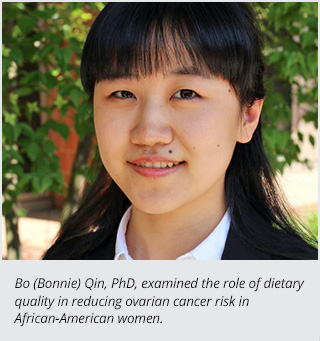Boosting Science to Reduce Cancer Health Disparities
Study presented at the AACR’s eighth annual cancer health disparities conference examines how improved diet reduced the risk of ovarian cancer in some African-American women.

Despite the substantial progress made in preventing and treating cancer in recent years – the five-year survival rate in the United States rose to 68 percent in 2010 from 49 percent in 1975 – significant differences remain for certain groups.
For example:
- African-American men have higher rates of prostate cancer and are more likely to die of the disease than men of other races and ethnicities.
- Cervical cancer rates are higher among Hispanic and African-American women than other women.
- Kidney cancer is more common among Native Americans than other groups.
- African-American women have a higher incidence of triple-negative breast cancer, a particularly aggressive form of the disease.
- Between 1975 and 2005, the five-year survival rate for white women in the United States with advanced ovarian cancer improved from 37 percent to 45 percent but declined for black women from 43 percent to 38 percent, according to data from the National Institute of Health’s Surveillance, Epidemiology, and End Results Program.
Each year the American Association for Cancer Research (AACR) holds a conference – The Science of Cancer Health Disparities in Racial/Ethnic Minorities and the Medically Underserved to discuss the latest research on cancer disparities and identify ways to improve outcomes for populations disproportionately affected by cancer.
The causes of cancer disparities are diverse and not fully understood, but scientists are working hard to gauge the impact of genetic factors – which would be difficult or impossible to change – and lifestyle factors – which are often modifiable and could be a key to reducing disparities.
Among lifestyle factors, researchers have pointed to higher rates of obesity among some racial, ethnic, and socioeconomic groups as one factor in cancer disparities.
At the 2015 disparities conference, a researcher at Rutgers Cancer Institute of New Jersey presented a study that showed that following a healthy diet may reduce the risk of ovarian cancer in African-American women. Ovarian cancer is the fifth leading cause of cancer death among women in the United States. African-American women are less likely than white women to be diagnosed with the disease, but more likely to die from it.

“This highlights a critical need for identifying preventive factors in African-Americans, particularly through dietary modification, which is relatively low-cost and low-risk compared to medical treatments,” said Bo (Bonnie) Qin, PhD, the postdoctoral associate who presented the study.
In the study, Qin, her mentor Elisa V. Bandera, MD, PhD, and fellow Rutgers researchers evaluated the impact of three index-based dietary patterns – the 2005 Healthy Eating Index (HEI-2005); the 2010 Healthy Eating Index (HEI-2010); and the Alternate Healthy Eating Index-2010 (AHEI-2010) – on ovarian cancer incidence in roughly 1,000 African-American women.
Qin found that among all African-American women in the study, those with the highest adherence to an AHEI-2010 diet were 34 percent less likely to be diagnosed with ovarian cancer than women with the lowest AHEI-2010 adherence.
Among postmenopausal women, the women with the highest quartile of HEI-2010 scores were 43 percent less likely to be diagnosed with ovarian cancer, and the women with the highest quartile AHEI-2010 scores were 51 percent less likely to be diagnosed with ovarian cancer than the women in the lowest quartile.
All three of the diets in Qin’s study feature an emphasis on fruits, vegetables, and whole grains, and limits on processed foods, sodium, added sugar, and alcohol. So, how do the diets differ? Here’s a quick look at their origins and specific recommendations:
- HEI-2005 was based on the federal Dietary Guidelines for Americans, and was designed to assess adherence to those recommendations.
- HEI-2010 reflected some updated recommendations, and has an added emphasis on the quality of a person’s diet (for example, including an increased emphasis on seafood and plant proteins and on reducing consumption of refined grains.)
- AHEI-2010 is based on a different nutrition guide, the Healthy Eating Pyramid. This diet also advocates that fruits, vegetables and whole grains make up the majority of a person’s intake. It has more specific recommendations for protein and fat sources, including nuts, legumes, and omega-3 fatty acids EPA and DHA.
Qin said that further research is necessary to determine whether all aspects of the healthier diets contributed to reduced risk, or whether specific nutrients conferred the benefits. She added that retrospective research into a person’s eating habits can be tricky, as it generally requires the person to remember and accurately report what they ate. But in an effort to improve health outcomes – in cancer and many other diseases – diet is a good place to start.
“As a high-quality diet is likely to have benefits for many chronic conditions, it is probably a safe bet for better health in general,” said Qin.
